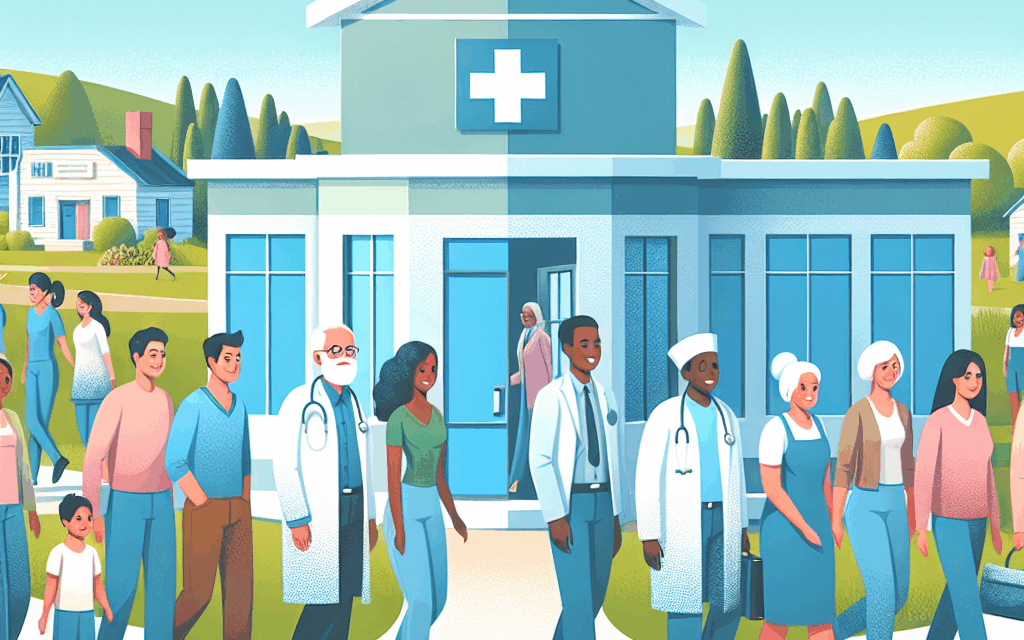Enhancing Healthcare Accessibility for Underserved and Marginalized Populations
Healthcare accessibility remains a critical issue worldwide, particularly for underserved and marginalized populations. These groups often face significant barriers to receiving adequate healthcare, leading to disparities in health outcomes. This article explores various strategies to enhance healthcare accessibility, focusing on five key areas: understanding the barriers to access, the role of technology, community-based initiatives, policy reforms, and the importance of cultural competence in healthcare delivery.
Understanding the Barriers to Healthcare Access
To effectively enhance healthcare accessibility, it is essential to understand the barriers that underserved and marginalized populations face. These barriers can be categorized into several key areas:
- Economic Barriers: Many individuals in marginalized communities lack the financial resources to afford healthcare services. High costs associated with medical care, insurance premiums, and out-of-pocket expenses can deter individuals from seeking necessary treatment.
- Geographic Barriers: Rural and isolated communities often have limited access to healthcare facilities. Long distances to the nearest hospital or clinic can discourage individuals from seeking care, particularly in emergencies.
- Cultural and Linguistic Barriers: Language differences and cultural misunderstandings can create significant obstacles in healthcare delivery. Patients may feel uncomfortable or misunderstood when interacting with healthcare providers who do not share their cultural background or language.
- Systemic Barriers: Institutional policies and practices can inadvertently perpetuate inequalities in healthcare access. For example, rigid appointment systems or lack of transportation options can disproportionately affect marginalized populations.
- Social Determinants of Health: Factors such as education, housing, and employment significantly influence health outcomes. Individuals from marginalized communities often experience adverse social determinants that contribute to poor health.
Addressing these barriers requires a multifaceted approach that considers the unique needs of each community. For instance, economic barriers can be mitigated through sliding scale payment systems or community health programs that offer free or low-cost services. Geographic barriers can be addressed by establishing mobile clinics or telehealth services that reach remote areas. Understanding these barriers is the first step toward creating effective solutions.
The Role of Technology in Enhancing Accessibility
Technology has the potential to revolutionize healthcare accessibility, particularly for underserved populations. The integration of digital health solutions can bridge gaps in care and improve health outcomes. Here are several ways technology can enhance healthcare accessibility:
- Telehealth Services: Telehealth has gained significant traction, especially during the COVID-19 pandemic. It allows patients to consult healthcare providers remotely, reducing the need for travel and minimizing exposure to infectious diseases. Studies have shown that telehealth can improve access to care for individuals in rural areas, where healthcare facilities may be scarce.
- Mobile Health Applications: Mobile health apps can empower patients by providing them with tools to manage their health. These apps can offer medication reminders, appointment scheduling, and access to health information, making it easier for individuals to engage with their healthcare.
- Health Information Technology (HIT): Electronic health records (EHRs) and health information exchanges (HIEs) can streamline patient care by ensuring that healthcare providers have access to comprehensive patient information. This can lead to better-coordinated care and improved health outcomes.
- Remote Monitoring Devices: Wearable devices and remote monitoring technologies can help patients manage chronic conditions from home. For example, individuals with diabetes can use continuous glucose monitors to track their blood sugar levels, reducing the need for frequent doctor visits.
- Online Health Education: Digital platforms can provide valuable health education resources tailored to the needs of marginalized populations. By offering culturally relevant information in multiple languages, these platforms can empower individuals to make informed health decisions.
While technology offers promising solutions, it is essential to address the digital divide that exists among underserved populations. Many individuals lack access to reliable internet or smartphones, which can limit their ability to utilize digital health resources. Therefore, initiatives that provide technology access and training are crucial for ensuring equitable healthcare delivery.
Community-Based Initiatives: A Grassroots Approach
Community-based initiatives play a vital role in enhancing healthcare accessibility for marginalized populations. These programs are often designed and implemented by community members who understand the unique challenges faced by their peers. Here are several successful community-based initiatives:
- Community Health Workers (CHWs): CHWs are trusted members of the community who provide education, support, and advocacy for individuals navigating the healthcare system. They can help bridge the gap between healthcare providers and underserved populations, ensuring that individuals receive the care they need.
- Mobile Clinics: Mobile clinics bring healthcare services directly to underserved communities. These clinics often provide preventive care, screenings, and vaccinations, making it easier for individuals to access essential services without the burden of travel.
- Health Fairs and Outreach Events: Community health fairs can provide free screenings, health education, and resources to underserved populations. These events often foster a sense of community and encourage individuals to take an active role in their health.
- Partnerships with Local Organizations: Collaborating with local organizations, such as schools, churches, and non-profits, can enhance outreach efforts. These partnerships can help identify community needs and mobilize resources to address them effectively.
- Peer Support Programs: Peer support programs connect individuals with similar health challenges, providing emotional support and practical advice. These programs can empower individuals to take charge of their health and navigate the healthcare system more effectively.
Community-based initiatives not only improve healthcare access but also foster trust and engagement within marginalized populations. By involving community members in the design and implementation of programs, these initiatives can be tailored to meet the specific needs of the population they serve.
Policy Reforms: Advocating for Change
Policy reforms are essential for creating a more equitable healthcare system. Advocating for changes at the local, state, and national levels can help dismantle systemic barriers that hinder access for underserved populations. Key areas for policy reform include:
- Expanding Medicaid and Medicare: Expanding eligibility for Medicaid and Medicare can significantly increase access to healthcare for low-income individuals. States that have expanded Medicaid have seen improvements in health outcomes and reductions in uninsured rates.
- Implementing Universal Healthcare: Advocating for universal healthcare can ensure that all individuals have access to necessary medical services, regardless of their financial situation. Countries with universal healthcare systems often experience better health outcomes and lower healthcare costs.
- Addressing Social Determinants of Health: Policies that address social determinants, such as housing, education, and employment, can have a profound impact on health outcomes. Investing in community resources and support systems can help mitigate the effects of poverty on health.
- Strengthening Anti-Discrimination Laws: Ensuring that healthcare providers adhere to anti-discrimination laws can help protect marginalized populations from bias and inequity in care. Policies that promote diversity and inclusion within healthcare settings are also crucial.
- Funding for Community Health Programs: Increased funding for community health programs can enhance outreach efforts and improve access to care for underserved populations. Policymakers should prioritize funding for initiatives that address the unique needs of marginalized communities.
Advocacy efforts must involve collaboration among healthcare providers, community organizations, and policymakers. By working together, stakeholders can create a unified voice that calls for meaningful change in healthcare policy.
The Importance of Cultural Competence in Healthcare Delivery
Cultural competence is essential for providing effective healthcare to underserved and marginalized populations. Healthcare providers must understand and respect the diverse cultural backgrounds of their patients to deliver appropriate care. Key components of cultural competence include:
- Awareness of Cultural Differences: Healthcare providers should be aware of the cultural beliefs, values, and practices that influence their patients’ health behaviors. This awareness can help providers tailor their approach to meet the needs of diverse populations.
- Effective Communication: Language barriers can hinder effective communication between patients and providers. Offering interpretation services and using plain language can improve understanding and foster trust.
- Building Trusting Relationships: Establishing rapport with patients is crucial for effective healthcare delivery. Providers should take the time to listen to their patients’ concerns and demonstrate empathy and respect.
- Training and Education: Ongoing training in cultural competence should be a priority for healthcare organizations. Providers should receive education on the cultural factors that impact health and strategies for delivering culturally sensitive care.
- Involving Community Leaders: Engaging community leaders in healthcare initiatives can enhance cultural competence. These leaders can provide valuable insights into the needs and preferences of their communities, helping providers deliver more effective care.
Culturally competent care not only improves patient satisfaction but also leads to better health outcomes. When patients feel understood and respected, they are more likely to engage in their healthcare and adhere to treatment plans.
Conclusion
Enhancing healthcare accessibility for underserved and marginalized populations is a multifaceted challenge that requires a comprehensive approach. By understanding the barriers to access, leveraging technology, implementing community-based initiatives, advocating for policy reforms, and promoting cultural competence, we can create a more equitable healthcare system. Each of these strategies plays a crucial role in addressing the unique needs of marginalized populations and ensuring that everyone has the opportunity to achieve optimal health.
As we move forward, it is essential for stakeholders—healthcare providers, policymakers, community organizations, and individuals—to collaborate and advocate for change. By working together, we can dismantle the barriers that hinder access to care and build a healthier future for all.





